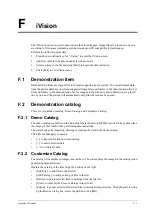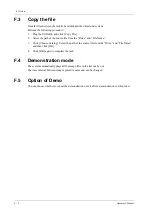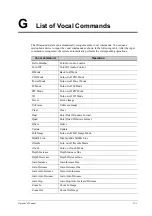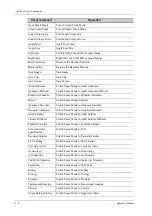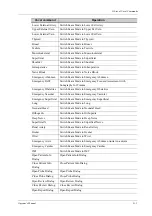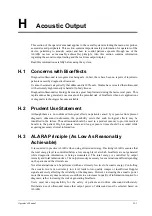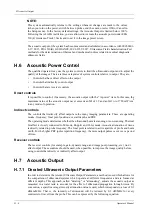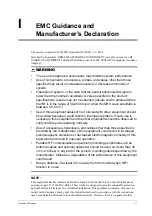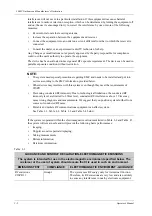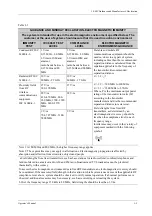
H Acoustic Output
Operator’s Manual
H - 5
Where I
atten
is the attenuated intensity, I
water
is the intensity measured in a water tank (at distance
z), fc is the center frequency of the ultrasound wave (as measured in water), and z is the distance
from the probe. The equation for attenuating pressure values is similar except that the attenuation
coefficient is 0.15 dB/cm/MHz, or one-half the intensity coefficient. The intensity coefficient is
double the pressure coefficient because intensity is proportional to the square of pressure.
Although the attenuation coefficient chosen, 0.3 dB/cm/MHz, is significantly lower than any
specific solid tissue in the body, this value was chosen to account for fetal examinations. In early
trimester ultrasound fetal examinations, there may be a significant fluid path between the probe and
the fetus, and the attenuation of fluid is very small. Therefore the attenuation coefficient was
lowered to account for this case.
H.7.2 Limits of Acoustic Output
In accordance with the FDA Track 3 requirements, the derating (or attenuated) approach was
incorporated into the FDA Acoustic Output Limits, as listed below. The maximum acoustic output
level from any probe in any operating mode is expected to fall below these limits.
FDA Maximum Acoustic Output Limits for Track 3 (Attenuated Values)
H.7.3 Differences between Actual and Displayed MI and TI
In operation, the system will display to the operator the Acoustic Output Parameters Thermal
Index, TI, or Mechanical Index, MI (or sometimes both parameters simultaneously). These
parameters were developed as general indicators of risk from either thermal or mechanical action of
the ultrasound wave. They serve to indicate to the operator whether a particular setting of the
system increases or decreases the possibility of Thermal or Mechanical effect. More specifically,
they were designed to assist in the implementation of the ALARA principle. As an operator
changes a given system control, the potential effect of the change in output will be indicated.
However, the Thermal Index is not the same as temperature rise in the body, for several reasons.
First of all, in order to provide a single display index to you, a number of simplifying assumptions
had to be made. The biggest assumption was the use of the attenuating formula described above,
which is much lower than the actual value for most tissues within the body. Scanning through
muscle or organ tissue, for example, will produce much higher attenuation than 0.3 dB/cm/MHz.
There were also significant simplifications made for the thermal properties of tissue. Therefore,
scanning through highly perfused tissue, such as the heart or vasculature, will produce significantly
less thermal effect than that suggested by the Thermal Index.
Similarly, the Mechanical Index was derived to indicate the relative possibility of mechanical
(cavitation) effects. The MI is based on the derated peak-rarefactional pressure and the center
frequency of the ultrasound wave. The actual peak-rarefactional pressure is affected by the actual
attenuation caused by tissue in the path between the probe and the focal point. Again, all solid
tissues within the body have higher attenuation than the proscribed 0.3 dB/cm/MHz value, and
therefore, the actual peak-rarefactional pressure will be lower. Further, the actual peak-rarefactional
pressure will change depending upon the region of the body being scanned.
For these reasons, the TI and MI displays should only be used to assist the operator in implementing
ALARA at the time of the patient examination.
Iatten
Iwater 10
0.3
–
10
fc z
=
Application:
Regions (except eyes)
I
spta.3
(mW/cm
2)
≤
720
I
sppa.3
(W/cm
2
)
≤
190 or MI
≤
1.9
Application: Ophthalmic
I
spta.3
(mW/cm
2)
≤
50
MI
≤
0.23
Summary of Contents for Anesus ME7T
Page 2: ......
Page 58: ...This page intentionally left blank ...
Page 154: ...This page intentionally left blank ...
Page 164: ...This page intentionally left blank ...
Page 182: ...This page intentionally left blank ...
Page 190: ...This page intentionally left blank ...
Page 208: ...This page intentionally left blank ...
Page 254: ...This page intentionally left blank ...
Page 264: ...This page intentionally left blank ...
Page 280: ...This page intentionally left blank ...
Page 311: ......
Page 312: ...P N 046 018839 00 5 0 ...





